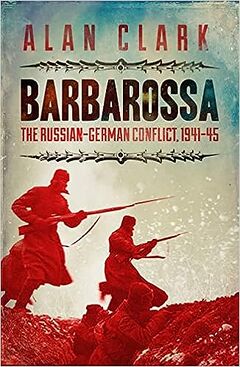Difference between revisions of "Operation Barbarossa"
m |
m |
||
| Line 1: | Line 1: | ||
{{event | {{event | ||
|wikipedia=https://en.wikipedia.org/wiki/Operation_Barbarossa | |wikipedia=https://en.wikipedia.org/wiki/Operation_Barbarossa | ||
| + | |constitutes=invasion | ||
|image=Barbarossa.jpg | |image=Barbarossa.jpg | ||
|image_width=240px | |image_width=240px | ||
Latest revision as of 11:08, 28 June 2024
 | |
| Date | 22 June 1941 - 1945 |
|---|---|
Operation Barbarossa was the invasion of the Soviet Union by Nazi Germany and its Axis allies starting on Midsummer's Day 1941, two years into the Second World War. It was the largest land offensive in human history, with over 10 million combatants taking part.
Originally code-named Operation Otto, the plan was renamed in December 1940 after a 12th-century Holy Roman emperor and German king Frederick Barbarossa ("red beard") and put into action Nazi Germany's ideological goal of conquering the western Soviet Union to repopulate it with Germans. Its ultimate aim was to create more Lebensraum (living space) for Germany, and the eventual extermination of the native Slavic peoples by mass deportation to Siberia, Germanisation, enslavement, and genocide.
Operation Barbarossa marked a massive escalation of World War II, both geographically and with the Anglo-Soviet Agreement, which brought the USSR into the Allied coalition.
Operationally, German forces achieved significant victories and occupied some of the most important economic areas of the Soviet Union (mainly in Ukraine) and inflicted, as well as sustained, heavy casualties. Despite these early successes, the German offensive stalled in the Battle of Moscow at the end of 1941, and the Soviet winter counteroffensive pushed the Germans about 250 km back.
The Wehrmacht's diminished forces could no longer attack along the entire Eastern Front, and subsequent operations to retake the initiative and drive deep into Soviet territory – such as Case Blue in 1942 and Operation Citadel in 1943 – eventually failed leading to the terrible turning point of the Battle of Stalingrad and the Fall of Berlin after the hard years of fighting and advance by the Red Army which resulted in the Wehrmacht's defeat and the collapse of the Nazi Party and German expansionism as World War II came to an end.[1]
Jonathan Dimbleby's version

- Operation Barbarossa, Hitler's invasion of Russia in June 1941, aimed at nothing less than a war of extermination to annihilate Soviet communism, liquidate the Jews and create Lebensraum for the German master race. But it led to the destruction of the Third Reich, and was cataclysmic for Nazi Germany with millions of men killed, wounded or registered as missing in action. It was this colossal mistake -- rather than any action in Western Europe -- that lost Hitler the Second World War.
- Drawing on hitherto unseen archival material, including previously untranslated Russian sources, Jonathan Dimbleby puts Barbarossa in its proper place in history for the first time. From its origins in the ashes of the First World War to its impact on post-war Europe, and covering the military, political and diplomatic story from all sides, he paints a full and vivid picture of this monumental campaign whose full nature and impact has remained unexplored.[2]
References
- ↑ "Barbarossa: The Russian-German Conflict, 1941-45" by Alan Clark
- ↑ "Barbarossa: How Hitler Lost the War" by Jonathan Dimbleby
Wikipedia is not affiliated with Wikispooks. Original page source here